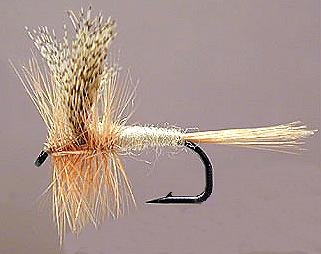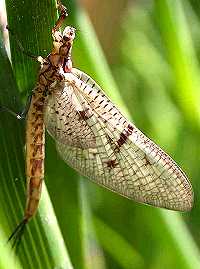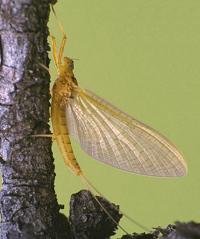The Light Cahill Dry Fly
The Light Cahill Flyfishing Dry Fly is a good trout surface fly. From the middle of May to September, depending on where you live, hatches of different varieties of light colored mayflies now commonly known as Light Cahills can be found.

DRY FLY PATTERNS. Hook size 12 14 16 18 20 24 - $US each
This is a recent collective common name that covers many groups of the Heptageniidae family of mayfly insects. In the 1880's a New York railroad worker called Daniel Cahill developed a fly that became famous all over America, the Light Cahill. When he wasn't fishing or tying flies he was a brakeman on the old Erie and Lackawana Railroad. It is a great general imitation of summer mayfly duns. Just choose the hook size and color to match your local hatch. It was originally designed to imitate a family of mayflies with the name of Stenonema. They begin hatching in late May and continue through June. In smaller sizes the Light Cahill is a useful fly to imitate hatches of Pale Morning Duns, Pale Watery Duns, Spurwings, Pale Evening Duns and the Red Quill Mayfly. The Pale Morning Dun (PMD) hatch is normally in the summer and massive in numbers, triggering aggressive trout feeding. The hatch normally happens in slow, clear water. The PMD is normally best matched with a size 18 hook fly. The Red Quill mayfly is not as widespread as other mayflies but if they live in the river you are fishing, you will find that this fly is an important insect to have imitations of. The reason being is that they occur in large numbers when they hatch and these are the flies that the trout want. Hatches are normally in the afternoon.

The Heptageniidae family of mayfly insects can be imitated by the Light Cahill dry fly
Dan Cahill is also credited with the unscheduled stocking of some Eastern North American rivers and streams with Rainbow trout. The story goes that on one steamy hot summer's day Dan was working a Lackawana freight train north of Port Jervis. The train's progress was blocked by a derailed work train. Part of the freight being carried that particular day was a large water container full of live stock rainbow trout. They were starting to cook. They would not survive the delay. Dan took action to save them from certain death. He talked his work mates into helping him carry them back to Calicoon Creek and let them go free. It was almost a mile back along the tracks. Their offspring have eventually spread throughout the whole Delaware watershead. Art Flick in his book "Stream Guide to Natural and their Imitations" said of the Light Cahill pattern, "To this date I have never met a fisherman who had fished any stream where trout could not be taken on this fly. It is doubtful if any fly compares with it in popularity, especially in the East." Ray Bergman author of "Trout" in 1938 commented on the light Cahill, "If it was necessary to confine my assortment of flies to only two or three, this would be one of them." He stated that although it is particularly effective in Catskill waters and similar mountain streams it had served him well in Michigan, Wyoming and California. He said, it is a "killing fly".

The Light Cahill Dry Fly can be used to imitate yellow drake mayflies
A Light Cahill on a size 10 hook is a useful pattern to imitate the Yellow Drake Mayfly. Yellow, Green and Brown Drakes are not the largest mayflies of the summer hatches but they are certainly much bigger than the early Blue Winged olive and Blue Dun hatches of early spring. They belong to the Ephemeridae family mayflies. They have all a deserved reputation for producing great hatches that can entice large lurker trout to leave their lays and feed greedily on the hatching Drakes. When they do hatch their emergence is not a subtle event. After breaking through the surface film and their nymphal shucks these large duns struggle frantically to get off the water. This makes them very conspicuous and easy prey for both birds and trout. They float for long distances waiting for their wings to fill with blood. When the wings are fully inflated and dry these duns flutter furiously as they try to lift their large bodies into the air. This fluttering action often is the trigger for some violent strikes.
As nymphs all three species prefer slow moving water that has a river bed of fine sand, gravels or silt. During a hatch you will find the greatest concentration in these same areas. The slow moving water gives the trout a very clear view of it's target. The Yellow Drake is the last of the three Drakes to emerge. Their hatches are normally in the middle of June and extend up to the middle of August. They can be found in freestone as well as limestone rivers. The are sometimes referred to as the 'Warmwater Drake' Summer low water conditions and rising water temperatures do not appear to upset them. they just emerge later in the day. Large concentrations are rarely seen on the water. They emerge sporadically but the trout and bass know it is Yellow Drake hatch time. Drift a Light Cahill on a size 10 hook over a quiet pool in the early evening and see what happens. Be ready to set the hook.

The Light Cahill Dry Fly pattern can imitate many upwing pale mayflies
CUSTOMER'S COMMENT
I use Light Cahill flies with success on rivers in North Georgia, Eastern Tennessee and Western North Carolina like the Hiawassee, Chattooga, Tellico and Davidson. They seem to work very well. The Light Cahill is easily my most favorite and productive fly. I usually use in size 14 - 16. Frank Booth, Gainesville GA
Fly Fishing books



